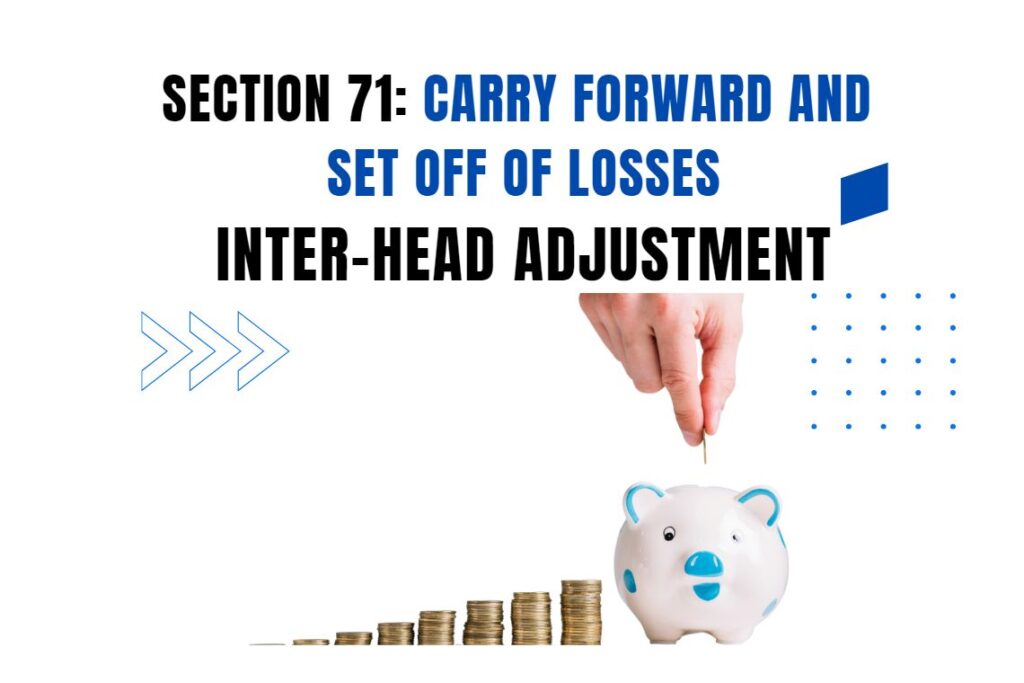Section 71B of the Income Tax Act, 1961, governs the carry forward and set-off of losses from house property, allowing taxpayers to optimize their tax liability by adjusting current-year losses against future income. Below is a detailed breakdown of the provisions:
1. Understanding Loss from House Property
A loss under the head “Income from House Property” arises when:
- Deductions(like municipal taxes, standard deduction @30%, and home loan interest) exceed the Gross Annual Value (GAV) of the property.
- Common scenarios include:
- Vacant property(no rental income).
- High home loan interest(especially for self-occupied properties, where deduction is capped at ₹2 lakh).
Example:
- Gross Annual Value (GAV): ₹3,00,000
- Less: Municipal taxes (₹20,000) + Standard deduction (30% of ₹2,80,000 = ₹84,000) + Home loan interest (₹2,50,000)
- Net Loss: ₹3,00,000 – (₹20,000 + ₹84,000 + ₹2,50,000) = ₹-54,000.
2. Set-Off Rules for House Property Loss
- Intra-Head Adjustment (Section 70)
- Loss from one house propertycan be set off against income from another house property under the same head.
Example:- Loss from Property A: ₹1,50,000
- Income from Property B: ₹1,00,000
- Net Loss: ₹50,000 (after intra-head adjustment).
- Inter-Head Adjustment (Section 71)
- Old Tax Regime:
- Loss can be set off against any other head(salary, business, capital gains, etc.) up to ₹2 lakh per year.
- Unadjusted loss beyond ₹2 lakh is carried forward.
- New Tax Regime (Default from FY 2023-24):
- No inter-head set-off allowed. Loss can onlybe adjusted against house property income.
Example (Old Regime):
- House Property Loss: ₹3,00,000
- Salary Income: ₹5,00,000
- Set-off: ₹2,00,000 (max) against salary → Taxable salary: ₹3,00,000
- Carry Forward: ₹1,00,000.
3. Carry Forward of Loss (Section 71B)
Key Provisions
| ASPECT | RULE |
| Carry Forward Period | 8 assessment years from the year of loss. |
| Set-Off in Future Years | Only against house property income (not other heads). |
| Filing Requirement | No deadline restriction: Loss can be carried forward even if ITR is filed belatedly. |
| Lapsing of Loss | Unadjusted loss lapses after 8 years. |
Example:
- AY 2024-25: Loss of ₹2,50,000 (partially set off).
- AY 2025-26: House property income of ₹1,00,000 → ₹1,00,000 adjusted → Remaining loss: ₹1,50,000 (carried forward to AY 2026-27).
4. Practical Scenarios
Scenario 1: Timely Set-Off
- Loss (AY 2024-25): ₹3,00,000
- Other Income (AY 2024-25): ₹1,50,000 (salary)
- Set-off: ₹1,50,000 (max ₹2 lakh) → Taxable Income: ₹0
- Carry Forward: ₹1,50,000.
Scenario 2: New Regime Restriction
- New Regime: Loss of ₹2,30,000 cannotbe set off against salary. Entire loss is carried forward.
5. Key Considerations
- Interest Deduction Limits:
- Self-occupied property: Max ₹2 lakh deduction on home loan interest.
- Let-out property: No limit; entire interest is deductible.
- Joint Ownership: Loss is apportioned among co-owners based on ownership share.
- Multiple Properties: Loss from one property can be set off against income from another.
6. Comparison: Old vs. New Tax Regime
| FEATURE | OLD REGIME | NEW REGIME |
| Inter-Head Set-Off | Allowed (up to ₹2 lakh) | Not allowed |
| Carry Forward | Yes (8 years) | No carry forward. |
7. Compliance Checklist
- File ITR on time(though belated filing is allowed for house property losses).
- Report losses accuratelyin Schedule HP of ITR.
- Track carry-forward lossesin Form 26AS






